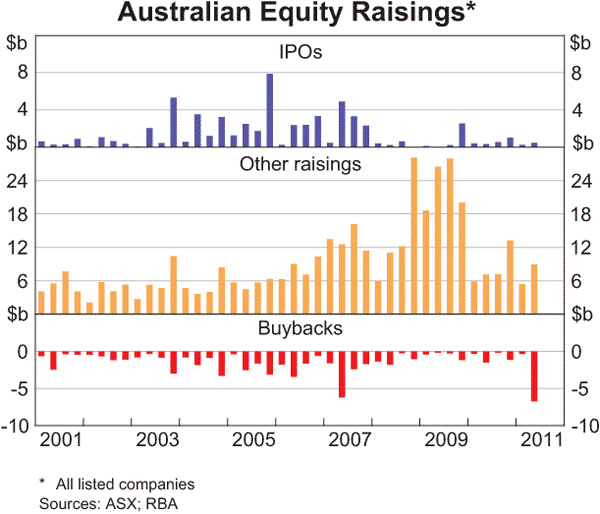
The lack of new capital raising in the Australian market is highlighted in a story in the Financial Review today. It is hardly surprising. According to Deutsche Bank, the ASX200’s performance between June 2009 and June 2011 is: 91%, relative to Europe, 84% relative to Asia ex-Japan and 80% relative to the US. That underperformance has improved a little over the last month but only because of the travails in the US and Europe.
The Fin story, based on Dealogic research, reveals just how deep the implications are of Australia’s Dutch disease. Innovation funded by new capital is being hammered, with obviously harmful implications for the narrowness of our industry base:
This year looks like being the worst for initial public offerings since 2002, the worst for equity issuance since 2005 and the lowest level of activity in total since 2003.
The raw numbers are bad in absolute terms and even worse relative to the rest of the world. The total value of Australian IPOs in the year to date is $560 million compared with global IPO deal value of $130 billion.
Normally, Australia accounts for about 2 to 3 per cent of global IPO activity but this year we hardly register on the scale.
The IPO market is dysfunctional because the three main sources of funds are on strike. Retail investors are not willing to step up to the plate when they can get 6.5 per cent in a bank deposit. Foreigners were big supporters of the QR National IPO last year but they have been missing in action ever since. They have been spooked by the uncertain political environment and the perception of heightened investment risk from the higher Australian dollar.
Domestic institutional investors are not willing to pay the prices being demanded by most vendors when there are so many cheap stocks available on the market.
This is a living, breathing example of the an often overlooked (but discussed by H&H here) symptom of Dutch disease called Rybczynski’s theorem. The illness that transpires when a boom sector sucks all of the capital out other parts of the economy.
Deutsche Bank points out that super funds continue to channel new money into the market to purchase equities — about $20 billion, not far below the peak in 2009 when companies were feverishly raising capital in the wake of the GFC. But it is almost exclusively going into the big end, as the Dealogic report argues. The Fin has an interesting take on what is happening:
The local super fund industry was once regarded as being like a wall of money because of the super guarantee charge. The regular payment of 9 per cent of salaries into super flowed seamlessly from super funds to equity capital markets as if a tap were permanently turned on. The money flowed automatically into panels of equity fund managers, and then into the market.
In 2011 that tap has been turned down to a trickle. The ECM teams at big banks have different theories on why this happened. One explanation is that the super funds have become more sophisticated in their asset allocation.
They have responded to the pressure to cut costs by keeping more of their business in-house. They are saving 30 to 50 basis points by keeping the money under their control. It is believed a lot of this money is going offshore or into alternatives.
The dysfunction in the IPO market is partly blamed on the attitude of its largest source of product – private equity. This year has seen many private equity vendors avoid the IPO market and instead sell businesses they own to trade buyers. Examples over the past 18 months include Contract Aviation, Ausco, National Hire and Study Group.
One way around the problem of closing the gap between sellers of assets and the IPO market would be to adopt the approach taken in the United States, where private equity sells about 20 per cent of the company up front. The remaining large shareholding is disposed of progressively over a number of years through a series of block trades.
This would allow time for the management of a company to prove itself and for the valuation to increase from the nine or 10 times earnings available these days.
The answer to the question as to why Australian companies are not raising much equity capital can be found in the huge issuance of equity in 2008 and 2009. Australian companies raised about $100 billion in new equity following the global financial crisis.
That equity was raised rapidly in a time of crisis. It showed how efficiently Australia’s capital markets could function when necessary. It helped save some companies from coming under the control of their bankers. But there are some who believe that the huge amount of issuance that occurred at that time has satisfied balance sheet demand for several years to come.
One large source of equity issuance that has been missing in 2011 is takeovers. Mergers and acquisitions by domestic companies are not happening.
It is not a pretty picture for the funnelling of capital into funding a diverse industry base. When one also considers the Labor government is preparing to stop stockbrokers sharing bonuses with staff — an inititaive that removes an important level of flexibility in the industry and will threaten the survival of many brokers in bear markets — and the narrowing of Australia’s industry base looks even more inevitable. Despite the fact that Australia’s $1.3 trillion super pool is the third largest of its type in the world.